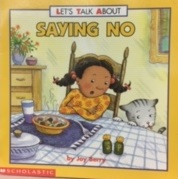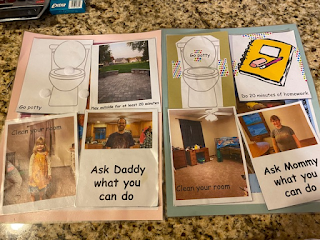November SEL -- Using Kind Language
November's SEL (Social-Emotional Learning) focus was using kind language. More specifically, we focused on how to solve conflict with others using kind words. It sometimes feel natural and maybe even justified to use mean words, but we can fix and keep friendships and good working relationships with others if we use kind words.
Kindergarten -- Saying, "No."
We read a book called, Let's Talk About Saying No. It talked about the right times to say no like when someone (a kid) asks us to do something we don't want to do or shouldn't do. We also talked about a kind way to say no:
Kindergarten -- Saying, "No."
We read a book called, Let's Talk About Saying No. It talked about the right times to say no like when someone (a kid) asks us to do something we don't want to do or shouldn't do. We also talked about a kind way to say no:
- "No, thank you."
- "No, but maybe later."
- "No, my mom/dad/teacher said I shouldn't."
We also talked about when we should say, "OK," or "Yes," like when a parent, teacher, or adults asks us to do something we need to do like clean up. To reinforce this lesson, we played the "Yes/No" game where students were asked to stand up if their answer to a question was "Yes" or "OK." The were to sit down if the answer was "No." We also did some modeling of kind ways to say, "No."
1st Grade -- A Bug and A Wish
This is one of the favorite lessons among teachers and me -- A Bug and A Wish. It's simply a way of telling someone that he/she is doing something that bothers us. An example would sound like this
"It bugs me when you interrupt me when I'm talking. I wish you would let me finish talking."
During this lesson, I explained to the 1st graders when and how to use a bug and a wish. Then, we did a LOT of practicing. When we practiced, I encouraged them to try to be specific about their wish. Simply saying, "Stop," sometimes works. If it doesn't, we need to be more specific about what we want them to do instead or what we want them to do next. If you use A Bug and A Wish at home, I encourage you to ask them to do them same.
2nd Grade -- I-Messages
In 2nd Grade, we built upon a Bug and a Wish to learn about I-Messages. No, we didn't learn about how to text from an iPhone. I-Messages are a way to tell someone that they did something that bothers you. It's the first step in problem solving. I showed the students that an I-Message would look like this:
"__________ [name of person], I feel _________ [emotion]
when you ______________________ [what they did].
I want you to, please, _________________________ [what you want them to do instead or what you want them to do next].
When we get to the last part when we tell them what we want them to do instead, we have every right to say, "Stop." At the same time, people don't always stop when we tell them to. We talked about ways to be more specific with this step, so that they would stop. For example, if someone is talking, we can tell them to stay quiet, hum or sing in their head, or wait. The I-Message would go like this
"John, I feel distracted when you talk to me when I'm working. I want you to, please, wait until snack time to talk to me."
Instead of telling John to stop talking, we told him to wait until a better time. Because we suggested a different behavior, John is more likely to change his behavior, which is what we want.
3rd Grade -- How to Handle Bullying and Teasing
In 3rd grade, we talked about how to respond with kind words when someone uses not-so-kind words. We talked about 3 different ways to respond:
There are many ways to solve problems using kind words!
2nd Grade -- I-Messages
In 2nd Grade, we built upon a Bug and a Wish to learn about I-Messages. No, we didn't learn about how to text from an iPhone. I-Messages are a way to tell someone that they did something that bothers you. It's the first step in problem solving. I showed the students that an I-Message would look like this:
"__________ [name of person], I feel _________ [emotion]
when you ______________________ [what they did].
I want you to, please, _________________________ [what you want them to do instead or what you want them to do next].
When we get to the last part when we tell them what we want them to do instead, we have every right to say, "Stop." At the same time, people don't always stop when we tell them to. We talked about ways to be more specific with this step, so that they would stop. For example, if someone is talking, we can tell them to stay quiet, hum or sing in their head, or wait. The I-Message would go like this
"John, I feel distracted when you talk to me when I'm working. I want you to, please, wait until snack time to talk to me."
Instead of telling John to stop talking, we told him to wait until a better time. Because we suggested a different behavior, John is more likely to change his behavior, which is what we want.
3rd Grade -- How to Handle Bullying and Teasing
In 3rd grade, we talked about how to respond with kind words when someone uses not-so-kind words. We talked about 3 different ways to respond:
- I-Messages -- We can use the I-Messages that we learned in 2nd grade to let someone know that we didn't like what someone said. (For more info, see the 2nd grade lesson summary above.)
- Turn an insult into a compliment -- When someone says something mean (an insult), pretend like they said something nice (a compliment). You can respond to mean things by saying:
- "Thank you!"
- "That's so kind of you!"
- "I always wanted to a be a nerd [or other mean name]."
Don't be afraid to use your acting skills with this strategy!
3. Ask questions -- People who bully and tease often do it to get a reaction out of someone. This strategy requires staying calm and asking the bully or teaser why they would say such mean things. When we practiced this strategy, we noticed that the person pretending to be the bully would often get confused or flustered after being asked several questions. Here are some example questions:
- "Why would you want to tell me that? It sounds mean."
- "Why are you talking to me if you don't like me?"
- "If you feel that way, why don't you ignore me?"
It's sometimes hard to think of all these questions on the spot, but this strategy can work well. Also, be forewarned: this strategy can sometimes lead to the supposed bully or teaser saying that you did or said something that made them upset. If this is the case, it's time for some problem solving.
There are many ways to solve problems using kind words!



Comments
Post a Comment